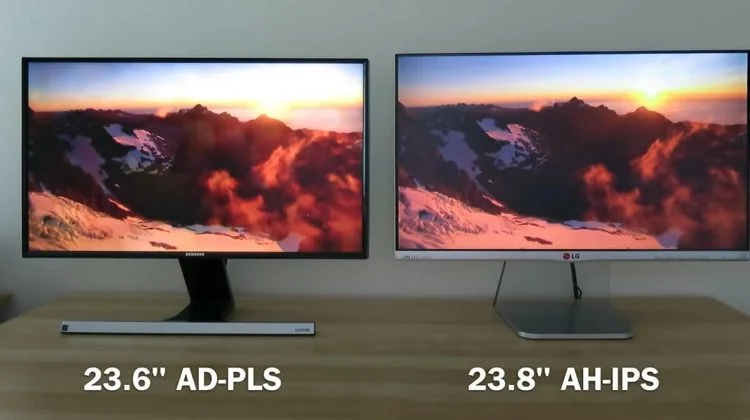What Is a PLS Screen?
PLS (Plane-to-Line Switching) is Samsung’s take on wide-angle TFT LCD technology, offering a powerful alternative to traditional IPS panels.
At its core, a PLS display uses the same horizontal alignment of liquid crystals as IPS—but with patented twists designed to:
- Deliver striking color uniformity, even from off-axis views
- Improve light transmittance, yielding brighter visuals at the same power
- Enhance overall image quality with Samsung’s proprietary refinements
PLS appears most often in Samsung-branded monitors, tablets, and professional-grade devices where consistent color across the screen is essential—even though it’s less widespread than IPS in the broader market.
What Is an IPS Panel?
IPS (In-Plane Switching) is the industry-standard wide-angle LCD technology found across brands like LG, Dell, and Apple. It was originally developed by Hitachi and gained traction for its:
- Ultra-wide viewing angles (up to 178°) with minimal color shift
- High color accuracy and depth suitable for color-critical applications
- Exceptional consistency across entire screen surfaces
This reliability has made IPS the default choice for high-end monitors, medical displays, creative tools, and precision industrial UIs.
PLS vs. IPS: How Do They Compare?
Here’s a side-by-side look at how PLS stacks up against IPS across key metrics:
| E Ink | PLS Screen | IPSパネル |
|---|---|---|
| 視野角 | Excellent (≈178°) | Excellent (≈178°) |
| Color Uniformity | Very high | Industry benchmark |
| Brightness Efficiency | Slightly higher | Depends on panel grade |
| Contrast & Black Level | Moderate (≈1000:1) | Slightly superior on premium IPS |
| 応答時間 | ~5–8 ms | ~5–8 ms |
| Cost Efficiency | Often more affordable | Varies with brand and quality |
| Ecosystem & Supply | Samsung-centric | Broad support (LG, AUO, BOE etc.) |
In practice, engineers often see PLS as Samsung’s optimized version of IPS. It delivers comparable or slightly better performance in some areas—especially perceived brightness and price—while staying true to IPS’s visual strengths.
Are PLS Screens Better Than IPS?
Not exactly—but not worse either.
For most users and industrial applications, the differences between PLS and IPS are subtle. However, here are a few practical distinctions worth noting:
- Power or brightness optimization: PLS panels may require less backlight for a given luminance, so they can deliver the same brightness with lower energy.
- Color-critical applications: Premium IPS panels, including variants like AH-IPS or Nano IPS, may still hold an edge for ultra-precise color workflows.
- Supply chain considerations: PLS is Samsung-specific, while IPS offers a broader vendor base—important for long-term procurement.
Where IPS Still Leads
IPS remains the go-to in settings where visual fidelity matters most:
- Professional photo/video editing and color grading
- Medical diagnostic displays
- High-end consumer tablets (e.g., iPads, Surface devices)
- Automotive infotainment systems demanding wide viewing angles
- Industrial user interfaces where consistent quality is key
Due to its broad manufacturer support and myriad panel grades, IPS offers flexibility in feature-rich or regulated applications.
Choosing Between PLS and IPS for Your Display Project
Here’s a practical matrix to help you decide:
| アプリケーション | Recommended Panel |
|---|---|
| General office or industrial GUI | PLSまたはIPS |
| 予算を考慮したハードウェア導入 | PLS |
| 色精度に優れたコンテンツ制作 | IPS(プレミアムグレード) |
| 高輝度または屋外表示ニーズ | PLSまたはハイエンドIPS |
| 幅広いディスプレイベンダーへのアクセスと互換性 | IPS |
最終的な選択には、パネルサイズ、インターフェース互換性(RGB/MIPI/LVDS)、輝度目標、予算、長期的な供給安定性も考慮する必要があります。
よくある質問
Q1: PLSスクリーンは単なるIPSの名称変更ですか?
正確には違います。PLSは同様の液晶物理特性を利用していますが、サムスンによる設計最適化(例えば光透過率の向上や均一性への注力)が含まれます。
Q2: PLSパネルは消費電力が少ないですか?
場合によります。光学効率の改善により、同じ電力予算でバックライトを減らしながら所定の輝度を達成できるためです。
Q3: IPSとPLSで同じ色再現性が期待できますか?
中間グレードのパネルでは差異は微妙です。高級カラー専門IPSパネルでは、一貫性におけるわずかな改善が認識される場合があります。
Q4: 既存製品のIPSディスプレイをPLSパネルに交換できますか?
パネルサイズ・タイミング仕様・電気インターフェースが一致すれば可能です。ただし表示調整やカラーマッピングの調整が必要な場合があります。
Q5: 屋外表示性能に優れるのは?
PLSはワットあたりの輝度効率で優れる可能性がありますが、光学ボンディングや防眩コートの採用で双方とも性能が大幅に向上します。
まとめ
TFT LCD PLSとIPSは 優れた視認性、広色域、強固な視野角を提供します。組込みシステム(特にサムスン互換機種)向けディスプレイモジュールを調達する場合、PLSはコスト削減と輝度向上をもたらします。一方、ベンダー選択肢の多さと高度な色調補正精度が必要な場合、IPSは柔軟性において圧倒的な強みを維持します。
要約:本質的に優劣はなく、アプリケーション要件に応じてそれぞれに適した領域が存在します。

